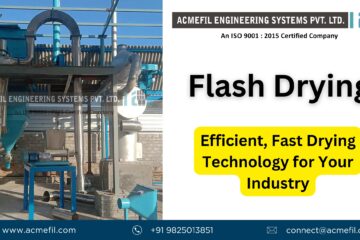Have you ever wondered how those perfectly preserved dried fruits maintain their vibrant colors and nutritional content? Or how food manufacturers can transform liquid food products into shelf-stable powders in a matter of seconds? The answer lies in flash drying—a revolutionary food preservation technique that’s transforming the industry. Today, approximately 40% of commercial food products undergo some form of drying process, with flash drying technology claiming an increasingly significant share of that market. This rapid dehydration method not only extends shelf life but also preserves more nutrients than traditional drying methods, making it a game-changer for both commercial producers and home food preservation enthusiasts.
In this comprehensive guide, we’ll explore everything you need to know about flash drying food—from the fundamental principles and equipment to practical applications and benefits. Whether you’re a food science professional, a business owner, or simply someone interested in advanced food preservation techniques, this in-depth resource will equip you with the knowledge to understand and leverage this powerful technology.
Table of Contents
What Is Flash Drying Food?
Flash drying (sometimes called “flash dehydration”) is a high-speed drying process that rapidly removes moisture from food products using intense heat over an extremely short time period. Unlike conventional drying methods that may take hours or even days, flash drying typically completes in seconds to minutes, depending on the specific application and equipment used.
The Science Behind Flash Drying
At its core, flash drying works on a simple principle: when moist food particles are exposed to a stream of hot air or heated surfaces for very brief periods, water rapidly evaporates without significantly heating the solid components of the food. This rapid moisture removal happens because:
- The extremely high temperature difference between the drying medium and the food creates a steep vapor pressure gradient
- The brief exposure time prevents the food from reaching temperatures that would cause thermal degradation
- The rapid moisture removal creates a “flash” effect as water converts immediately from liquid to vapor
This process creates a unique phenomenon: the food’s surface moisture evaporates so quickly that it actually cools the food through evaporative cooling, protecting it from heat damage despite the high temperatures used in the process.
Flash Drying vs. Traditional Food Drying Methods
To understand why flash drying has gained such prominence, let’s compare it with conventional drying approaches:
| Feature | Flash Drying | Conventional Air Drying | Freeze Drying |
|---|---|---|---|
| Drying Time | Seconds to minutes | Hours to days | 24+ hours |
| Temperature | Very high (150-600°C), brief exposure | Moderate (50-90°C), extended exposure | Very low (-40°C and below) |
| Energy Consumption | Moderate to high | Low to moderate | Very high |
| Nutrient Retention | High | Moderate | Very high |
| Color/Flavor Preservation | Excellent | Fair to good | Excellent |
| Equipment Cost | High | Low to moderate | Very high |
| Processing Complexity | Moderate | Low | High |
As the comparison shows, flash drying offers a compelling middle ground—combining the speed and efficiency of high-temperature processing with preservation qualities closer to freeze drying but at a fraction of the time and energy cost.
Types of Flash Drying Systems for Food Applications
The food industry employs several variations of flash drying technology, each with specific advantages for different food products:
1. Flash Drum Dryers
Flash drum dryers consist of heated rotating drums where thin layers of liquid or pureed food are applied. The intense heat causes nearly instantaneous evaporation, and dried food flakes are scraped off within seconds. These systems excel at processing:
- Fruit and vegetable purees
- Dairy products like milk and whey
- Cereal slurries and semi-liquid foods
- Food waste valorization streams
2. Spray Flash Dryers
In spray flash drying, liquid food products are atomized into tiny droplets and sprayed into a chamber with extremely hot air. The massive surface area of the droplets allows for near-instantaneous moisture removal. Common applications include:
- Creating milk powder and dairy ingredients
- Drying coffee and tea extracts
- Converting fruit juices to powder form
- Producing egg powder and other protein concentrates
3. Pulse Combustion Dryers
This specialized type of flash dryer uses rapid pulses of combustion gases to create intense but ultra-brief heat exposure, perfect for:
- Heat-sensitive nutrients and flavors
- Proteins and enzyme products
- Specialty ingredients requiring precise moisture control
- High-value food compounds
4. Pneumatic Flash Dryers
These systems suspend food particles in a high-velocity, heated air stream, quickly removing moisture while transporting the dried product through the processing line. They’re particularly effective for:
- Grains and starches
- Fibrous food materials
- By-products from food processing
- Materials that benefit from physical particle modification during drying
Key Benefits of Flash Drying in Food Processing
The rapid growth of flash drying technology in food applications stems from its numerous advantages:
Superior Nutrient Retention
Because flash drying exposes food to high temperatures for only seconds, heat-sensitive vitamins, antioxidants, and bioactive compounds have minimal time for degradation. Studies have shown that flash-dried fruits can retain up to 93% of their vitamin C content, compared to just 65% with conventional hot-air drying methods.
Enhanced Flavor and Color Preservation
The brief heat exposure in flash drying minimizes the Maillard reaction and caramelization processes that can alter flavor compounds and natural food pigments. This results in dried products with vibrant colors and flavor profiles remarkably similar to fresh foods.
Microbial Safety Without Chemical Preservatives
The rapid temperature spike during flash drying effectively eliminates many pathogenic bacteria, yeasts, and molds without requiring chemical preservatives. Research indicates that properly calibrated flash drying systems can achieve 5-log reductions in microbial counts while maintaining food quality—making it an excellent option for clean-label products.
Energy Efficiency at Scale
While flash drying systems require intense heat, their extremely short processing times translate to surprising energy efficiency when operating at commercial scale. Modern flash drying facilities can process thousands of pounds of food per hour with energy consumption 30-40% lower than equivalent freeze-drying operations.
Extended Shelf Life Without Refrigeration
Flash-dried food products typically have moisture content below 5%, creating an environment inhospitable to microbial growth and enzymatic reactions. This permits ambient temperature storage for months or even years while maintaining quality—a significant advantage for distribution in regions with limited cold chain infrastructure.
Commercial Applications of Flash Drying in the Food Industry
Flash drying technology has revolutionized numerous food product categories:
Dairy Industry
Flash drying has transformed dairy processing, enabling the creation of highly functional milk powders, whey protein concentrates, and specialized dairy ingredients. The rapid drying preserves protein functionality and prevents excessive denaturation, resulting in superior solubility and flavor profiles compared to conventional spray drying.
Fruit and Vegetable Processing
The ability to rapidly remove moisture while preserving color, flavor, and nutrients has made flash drying particularly valuable for fruit and vegetable processing. Products include:
- Instant fruit powders for beverages and confections
- Vegetable powders for soups, seasonings, and nutritional supplements
- Fruit and vegetable inclusions for bakery and snack foods
- Natural food colorants derived from fruits and vegetables
Coffee and Tea Production
Flash drying technology produces premium instant coffee and tea products with superior aroma retention and flavor release. The rapid dehydration captures volatile compounds that would otherwise be lost during traditional drying methods.
Functional Ingredients and Specialty Foods
Some of the most innovative applications of flash drying are found in specialty food ingredients:
- Encapsulated flavor compounds
- Probiotics and heat-sensitive nutritional ingredients
- Natural food coloring agents
- Texture-modifying agents for food formulation
Plant-Based Proteins and Alternative Foods
The growing plant-based food sector relies heavily on flash drying to create protein isolates, textured vegetable proteins, and innovative meat alternatives with improved texture and functionality.
Flash Drying Equipment: Technology and Considerations
Implementing flash drying requires specialized equipment designed for rapid heat transfer and precise process control.
Key Components of Flash Drying Systems
Modern flash drying systems integrate several critical components:
- Heat Generation Units – High-efficiency burners or electric heating elements capable of rapidly achieving temperatures between 150-600°C
- Product Feeding Mechanisms – Precisely calibrated systems for introducing food materials at the optimal rate and particle size
- Drying Chambers – Engineered environments where heat transfer and moisture removal occur under carefully controlled conditions
- Air Handling Systems – High-velocity fans and ducting that control airflow patterns for maximum drying efficiency
- Separation Equipment – Cyclones or bag filters that separate dried product from the air stream
- Control Systems – Advanced instrumentation and software managing temperatures, flow rates, and residence times with split-second precision
Scale Considerations: Industrial vs. Smaller Operations
While industrial flash dryers may process tons of material hourly, smaller-scale flash drying systems are increasingly available for specialty food producers, research facilities, and even advanced commercial kitchens.
Compact flash dryers with capacities of 5-50 kg/hour now allow smaller operations to access this technology, though with higher per-unit production costs than industrial-scale systems. These smaller units typically range from $50,000-200,000, compared to million-dollar investments for full production lines.
Energy Sources and Sustainability
Flash drying systems traditionally relied on natural gas or propane for rapid heat generation, but newer designs increasingly incorporate:
- Electric heating for operations with access to renewable electricity
- Hybrid systems that recover and recycle process heat
- Biomass-powered options for food processing in agricultural regions
- Heat pump integration for improved energy efficiency
Leading manufacturers now offer flash dryers with energy recovery systems that can reduce fossil fuel consumption by up to 40% compared to conventional designs from just a decade ago.
Process Parameters and Optimization for Flash Drying Foods
Successful flash drying requires precise control of multiple process variables:
Critical Process Variables
- Inlet Temperature – The initial temperature of the drying medium, typically ranging from 150-600°C depending on the food material
- Residence Time – The duration food particles spend in the heated environment, usually measured in seconds
- Particle Size – The dimensions of food particles, which directly impact heat transfer efficiency and drying time
- Initial Moisture Content – Starting water content of the food material
- Air Velocity – Speed of air movement through the system, affecting both heat transfer and particle transport
- Feed Rate – The quantity of material processed per unit time
Product-Specific Considerations
Different food materials require specific flash drying protocols:
- High-Sugar Foods (fruits, syrups) – Require careful temperature control to prevent caramelization and sticking
- Protein-Rich Foods (dairy, eggs, meat) – Need precise residence times to prevent denaturation and functionality loss
- Starch-Based Foods (potatoes, grains) – Benefit from controlled gelatinization during the process
- High-Oil Foods (nuts, seeds) – May require modified atmospheres to prevent oxidation during drying
Process Monitoring and Quality Control
Modern flash drying operations employ sophisticated monitoring systems:
- Inline moisture analyzers providing real-time feedback on drying effectiveness
- Vision systems assessing color and physical characteristics of dried products
- Temperature mapping throughout the drying chamber
- Product sampling protocols for post-process validation
Quality Attributes of Flash-Dried Food Products
Flash drying produces food ingredients with distinct quality characteristics:
Physical Properties
- Particle Morphology – Flash-dried particles typically have porous, expanded structures due to rapid moisture removal
- Rehydration Behavior – Superior rehydration rates compared to conventionally dried products
- Flow Characteristics – Generally excellent flowability due to low moisture content and limited particle agglomeration
- Density – Typically lower bulk density than other dried forms, though this varies with specific process parameters
Chemical Stability
Flash drying excels at preserving food chemistry:
- Minimal protein denaturation compared to conventional drying
- Reduced oxidation of lipids due to brief heat exposure
- Better retention of heat-sensitive vitamins (particularly B vitamins and vitamin C)
- Lower Maillard reaction products that can affect flavor and nutrition
Organoleptic Properties
The sensory characteristics of flash-dried foods often closely resemble the original products:
- Clean flavor profiles without the “cooked” notes common in conventional drying
- Vibrant, natural coloration
- Rapid flavor release upon rehydration
- Crisp texture that transforms effectively when moisture is reintroduced
Challenges and Limitations of Flash Drying Technology
Despite its advantages, flash drying presents certain challenges:
Technical Challenges
- Heat Transfer Precision – Maintaining optimal heat exposure within seconds requires sophisticated engineering and control systems
- Particle Movement Control – Ensuring uniform treatment of all particles despite variations in size and density
- Equipment Wear – High temperatures and rapid particle movement can cause accelerated wear on system components
- Scaling Consistency – Maintaining product quality when scaling from pilot to production systems
Product Limitations
Not all food materials are ideal candidates for flash drying:
- Very high-fat foods may experience oxidation despite the brief heat exposure
- Products requiring specific crystalline structures may develop unwanted amorphous states
- Some flavor compounds may still volatilize even with rapid processing
- Certain functional properties may be altered despite the brief processing time
Cost Considerations
The economic factors affecting flash drying implementation include:
- Higher initial capital investment compared to conventional drying systems
- Specialized maintenance requirements for high-temperature components
- Energy costs, particularly in regions with expensive natural gas or electricity
- Operator training for the sophisticated control systems
Innovations and Future Trends in Flash Drying Technology
The field of flash drying continues to evolve with several promising developments:
Hybrid Drying Systems
New systems combine flash drying with other technologies:
- Flash-assisted freeze drying, using brief heat pulses to accelerate sublimation
- Microwave-enhanced flash drying for improved energy transfer
- Ultrasonic-assisted flash systems for enhanced moisture migration
- Sequential processing combining flash with gentler secondary drying
Advanced Control Systems
The integration of artificial intelligence and machine learning is revolutionizing flash drying:
- Real-time process optimization based on continuous product quality monitoring
- Predictive maintenance systems that anticipate component failures
- Energy management algorithms that minimize consumption while maintaining quality
- Digital twins modeling the entire drying process for virtual experimentation
Novel Applications
Emerging applications for flash drying technology include:
- Functional food ingredients with preserved bioactivity
- Pharmaceutical-food hybrids requiring precise moisture control
- Upcycled food ingredients from processing by-products
- Customized nutrition formulations with precise ingredient stability
Implementing Flash Drying: Practical Considerations
Organizations considering flash drying technology should evaluate several factors:
Feasibility Assessment
Before investing in flash drying systems, conduct thorough analysis:
- Product compatibility testing in pilot facilities
- Sensory evaluation comparing flash-dried products to alternatives
- Shelf-life studies under various storage conditions
- Cost-benefit analysis including energy, labor, and maintenance
Regulatory Compliance
Flash drying operations must address regulatory requirements, including:
- Food safety validation studies demonstrating pathogen control
- Process validation protocols for consistent quality assurance
- Equipment design meeting sanitary standards
- Documentation systems for traceability and quality assurance
Training and Expertise
Successful implementation requires:
- Operator training on both routine operation and troubleshooting
- Engineering support for system optimization
- Quality assurance personnel familiar with dried food specifications
- Maintenance staff capable of servicing specialized components
Case Studies: Success Stories in Flash Drying Food Applications
Case Study 1: Dairy Ingredient Innovation
A leading dairy processor implemented a custom flash drying system for whey protein production, resulting in:
- 32% higher protein functionality retention
- 45% reduction in processing time
- 28% energy savings compared to their previous drying method
- New premium product lines commanding 20% price premiums
Case Study 2: Fruit Processing Transformation
A tropical fruit processor transitioning from conventional to flash drying technology experienced:
- 87% improvement in color retention
- 93% increase in production capacity
- 40% reduction in quality rejections
- Successful entry into premium markets previously unreachable with conventional dried products
Case Study 3: Specialty Ingredient Manufacturer
A producer of natural food colorants adopted flash drying technology:
- Achieved 99.2% pigment retention compared to 78% with previous methods
- Reduced processing footprint by 60%
- Decreased production costs by 24%
- Enabled new water-soluble powder formats previously impossible to produce
DIY and Small-Scale Flash Drying Applications
While industrial flash drying requires significant investment, smaller-scale applications are becoming accessible:
Pilot Scale Options
Several equipment manufacturers now offer semi-automated flash drying units suitable for:
- Product development laboratories
- Small specialty food producers
- University research facilities
- Co-packing operations serving multiple small brands
These systems typically process 2-20 kg per hour and provide excellent platforms for concept validation before larger investments.
Modified Equipment Approaches
Some food entrepreneurs have successfully adapted existing equipment for flash drying principles:
- Modified drum dryers with enhanced heat transfer surfaces
- Custom spray dryers with reconfigured atomization and airflow patterns
- Specialized fluid bed systems with intensified heat zones
- Hybrid systems combining multiple drying mechanisms
While these approaches cannot match the performance of purpose-built flash dryers, they offer accessible entry points to explore the benefits of rapid dehydration.
Conclusion
Flash drying represents one of the most significant advancements in food preservation technology in recent decades. By dramatically reducing drying times from hours to seconds, it creates new possibilities for food products with superior nutrition, flavor, color, and functionality. As energy efficiency continues to improve and equipment becomes more accessible, we can expect to see flash-dried ingredients appearing in an ever-widening array of food products.
Whether you’re a food scientist exploring new ingredient possibilities, a processor looking to improve product quality, or an entrepreneur developing innovative food concepts, flash drying technology offers compelling advantages worth serious consideration. The combination of quality preservation, processing efficiency, and extended shelf life without refrigeration makes it a powerful tool in addressing both consumer preferences for minimally processed foods and global challenges in food distribution and security.
As we look to the future, continued refinements in flash drying technology will likely make it even more energy-efficient, accessible at smaller scales, and capable of handling an expanding range of food materials—further cementing its place as an essential technology in modern food processing.




